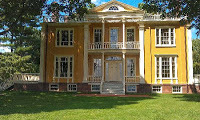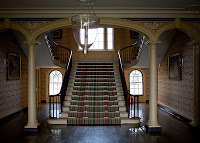Darcy on the Hudson - Research and Background #2

The Bennet family home was modeled on Boscobel (pretty woodlands) now located in Garrison, New York overlooking the Hudson River. It was built in the early 19th century by States Dyckman and is an outstanding example of the Federal style of American architecture. Boscobel's distinguishing feature is the unusual delicacy conveyed by the front facade and its ornamentation.
From Wikipedia: “Dyckman, a descendant of early Dutch settlers of Manhattan, had managed to retain his family fortune despite being an activeLoyalist... In 1794, he married Elizabeth Corne, daughter of another Loyalist family, who was twenty-one years his junior. After three years in London, Dyckman returned to the United States in 1803 and set about building the house he had long planned. Dyckman died in 1806 before it was finished. His widow completed it, and she and their surviving son moved into it in 1808. It would stay in the family until 1920.
"For the next 35 years, under subsequent owners, it frequently faced the possibility of being demolished. In 1955 an organization called Friends of Boscobel saved it at the last minute from a contractor who had bid $35 to knock it down after the Veterans’ Administration had built a hospital on the site. They arranged for it to be moved to a similar location upriver near Garrison, New York. Lila Acheson Wallace, wife of Reader’s Digest founder DeWitt Wallace provided the $50,000 or the move and reconstruction.”
 Moving Boscobel to its new location
Moving Boscobel to its new locationboscobel.org
During restoration, every salvageable piece was numbered and then moved to the new site in Garrison in 1957. The rebuilt home was formally reopened on May 21, 1961. In the late 1970s, new papers of Dyckman's were discovered, and the house was closed for six months in 1977 while it was redecorated in a manner more consistent with his recorded tastes.”
Distinguishing features:
The entry hall - As the largest room in the house, it served several purposes. This is where guests would be received and was the site of cotillions and musicales. The triple arch separated the public and private areas.
 Entryway - boscobel.orgAfter admiring displays of fine porcelains, the company returned to the magnificent entry hall, the largest room in the house, with its faux marble wallpaper, triple arch, and grand staircase lit by a rose window on the landing. In addition to serving as a place to welcome visitors, it was used for dancing, musicales, charades, plays, and card games.The remainder of the evening was divided between dancing to tunes played by Miss Darcy and the four favorites that could be played on the barrel organ. Mr. and Mrs. Bennet joined the young dancers, and at the end of the evening, Mary was coaxed on to the dance floor by Georgiana. (p. 40)
Entryway - boscobel.orgAfter admiring displays of fine porcelains, the company returned to the magnificent entry hall, the largest room in the house, with its faux marble wallpaper, triple arch, and grand staircase lit by a rose window on the landing. In addition to serving as a place to welcome visitors, it was used for dancing, musicales, charades, plays, and card games.The remainder of the evening was divided between dancing to tunes played by Miss Darcy and the four favorites that could be played on the barrel organ. Mr. and Mrs. Bennet joined the young dancers, and at the end of the evening, Mary was coaxed on to the dance floor by Georgiana. (p. 40)Drawing rooms – The front drawing room featured Duncan Phyfe furniture and was modeled on the Robert Adam interiors then so popular in England. The rear drawing room contains a 1796 English model barrel organ that could play four tunes.
In the front parlor, Mr. Bennet asked Charles what he thought of the carved fireplace that reminded Darcy of the Adam’s fireplaces at Pemberley with their detailed fretwork and neoclassical embellishments...“It is finely carved, sir. May I ask what wood was used?”“You may, Charles, but I will tell you that no wood was used. It is plaster painted to look like wood, and made at a manufactory I own on the west side of the river. It costs a fraction of what is required for marble. With a growing shortage of wood here in the lower valley, finding an alternative was a necessity.” (p. 40)
Dining room – The dining room chairs are made of maple painted to look like bamboo, thus introducing an Eastern influence into the room.
 Dining Room - From boscobel.orgIn the dining room, Darcy noted the fine furnishings and service, including a lovely set of Serves porcelain china, with each plate and bowl individually painted with a different scene of the French countryside. There were cut glass candelabra and a fireplace with plasterwork on the mantle depicting a Roman chariot race that he admired. All in all, it was an impressive room. (p. 80)
Dining Room - From boscobel.orgIn the dining room, Darcy noted the fine furnishings and service, including a lovely set of Serves porcelain china, with each plate and bowl individually painted with a different scene of the French countryside. There were cut glass candelabra and a fireplace with plasterwork on the mantle depicting a Roman chariot race that he admired. All in all, it was an impressive room. (p. 80)Kitchen – The kitchen includes a primitive rotisserie where meats would be “done to a turn.” (p. 80)
In the Bennet kitchen, Mrs. Kraft, Mrs. MacTavish, and Mrs. Wesley were busy baking pies with every possible fruit filling, including Marlborough pies, brimming with apple and lemon custard [for Thanksgiving]. The five Bennet daughters and all the help were either assisting in the baking or at Mrs. Bennet’s beck and call running back and forth from the pantry cupboard, springhouse, or woodpile bringing needed ingredients to the bakers or kindling to those tending the fires. (p. 226)
Boscobel is one of the glories of the Hudson River Valley. You can learn more by visiting their blog.
Published on November 14, 2013 23:05
No comments have been added yet.
What readers are saying about The Second Date
I loved reading about the history of the families and how it was woven into the story. I felt right at home reading about Sonia and her family. It reminded me so much of my childhood growing up in the
I loved reading about the history of the families and how it was woven into the story. I felt right at home reading about Sonia and her family. It reminded me so much of my childhood growing up in the South and I found myself laughing out loud when reading about the one room no one was allowed to sit in with the plastic on the furniture and having to have a mediator at funerals. - C. Mason
Sonia Amundsen is a likable and feisty heroine, who is starting to think she isn't going to find her perfect man. It's not a predictable path to love and I really I loved the romance. The Second Date is an engaging picture of a close knit and vibrant group of friends and family in a community that has its share of fun, food, chaos and craziness. I found it a fascinating peek into the complexities and pressures of their lives and romances. It has depth and insight into the things in our pasts, our lives and families that make us who we are, with warmth, humour and realism. - Portia ...more
Sonia Amundsen is a likable and feisty heroine, who is starting to think she isn't going to find her perfect man. It's not a predictable path to love and I really I loved the romance. The Second Date is an engaging picture of a close knit and vibrant group of friends and family in a community that has its share of fun, food, chaos and craziness. I found it a fascinating peek into the complexities and pressures of their lives and romances. It has depth and insight into the things in our pasts, our lives and families that make us who we are, with warmth, humour and realism. - Portia ...more
- Mary Lydon Simonsen's profile
- 181 followers



